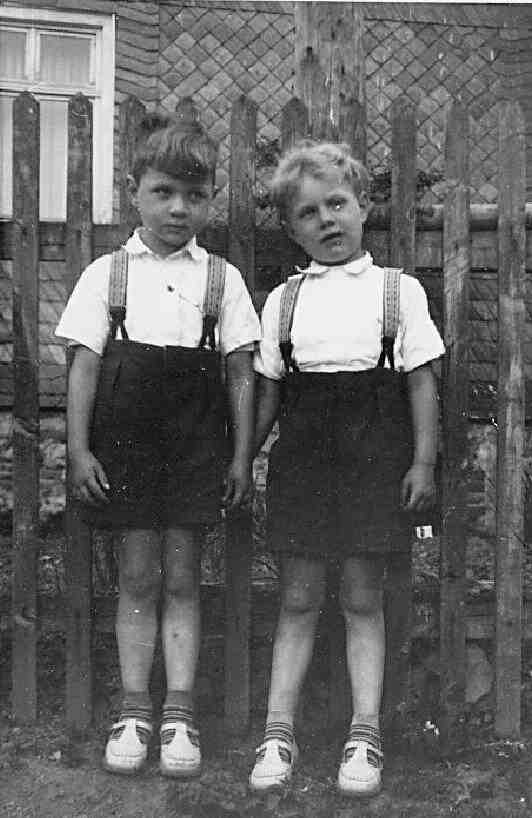
Figure 1.--Here are two German boys, surely brothers. The snapshot is undated, but we would guess was taken in the 1940s. They wear white t-strap sandals and short striped socks. I haven't noted German boys commonly wearing this style of sandal. |

|
We do not yet have sufficent German images to fully assess chronologicl trends of closed-toe sandals. We have, however, begun the process. We note German boys wearing formal strap shoes in the 19th century At the time this seem to have been a formal shoe, althoughh it was a formal shoe. In the 20th century we note German boys wearing both formal dress shoes and and casual sandals. The style of some of these shoes and sandals were identical. Colors and materials might vary. The most common tyles seems to have been single bar sandals, but we have seen other styles as well.
We note younger German boys wearing strap shoes as a kind of dress shoe. An example is an infant German boy about 1870. We do not note boys wearing what we call casual sandals at this time.
We note many images of German children, both boys and girls, wearing closed-toe sandals in the 1920s. We see quite a number of German boys wearing the single bar style without a center strap. This appears to have been more of a casual than a dress style. A good example is two children in the early 1920s. Another example is a German boy wearing strap shoes with rompers. WE also seen some photographs of boys wearing the single strap sandals with a center strap. A good example is a portrait of two brothers photographed about 1920, although it could have ben taken in the 1910s.
We rarely see German boys wearing other casual footwear like sneakers (canvas shoes).
We still see German boys in the early 1930s wearing sandals. An example is a German boy playing with a brother or friend at home. The image is undated, but we would guess was tken about 1930. The popularity of closed-toe sandals for boys declined in the 1930s, espcially after the NAZI take over. We still rarely see canvas tennis shoes. We do not, however, cloth strap shoes. An example here is a younger German boy wearing rompers.
On a previous page we see a German boy wearing "T" strap sandals probably in the late 1940s or early 50s. This is a style that was most common in England, but we see them being worn in Europe as well. Here we see two German boys, surely brothers (figure 1). The snapshot is undated, but we would guess was taken in the 1940s. They wear white t-strap sandals and short striped socks. I haven't noted German boys commonly wearing this style of sandal.
WE notice boys wearing a variety of closed-toe sandals during the 1950s. An ecanple was a Kindergarten boy about 1950. He was wearing double-bar sandals, but this was not the most common style. We still see some boys wearing the "T"-strap English style. A good example is a German boy in the early 1950s. We see another boy later in the decade. German boys in the 1950s began to wear open-toe sandals which became the dominant style. Quite a range of these open toe sandals appeared in Germany.
A HBC contributor provides the following reportvon the 1960s: I was in Germany from early 1962 to late 1964, almost 3 years. The kind of T-strap shoes I saw when I was there had a wide vertical strap--about 3 times the width of the cross-strap. My personal knowledge covers only Northern West Germany (from Hannover and Bremen to the Danish border). But within that area at that time brown and tan T-strap shoes were fairly common, and
were worn by boys and men of all ages (from under 4 to over 50). Even teenagers, who are notoriously skittish about wearing anything that their peers might think "odd," sometimes wore them for casual wear--most commonly in the Summer, but also in with ski-pants and jackets in the winter. However, they were much more common on boys younger than about 12. Younger boys frequently wore them with sportshirts and Lederhosen in the summer (or with white dress-shirts and white knee socks for dress-up occasions). and with ski-pants and jackets in the winter. In early 1962, I saw a contemporary documentary of a German Merchant
Marine training school. The students appeared to be in their late teens to possibly early twenties. They wore uniforms, apparently including T-strap shoes. In one scene of the boys and/or young men getting ready for the day, the camera zoomed in on someone buckling his shoes.
By the 1970s we rarely see German boys wearing closed-toe sandals.
Navigate the Boys' Historical Clothing Web Site:
[Return to Main German closed-toe sandal page]
[Return to Main shoe and sandal page]
[Return to Main German page]
[Introduction]
[Activities]
[Biographies]
[Chronology]
[Clothing styles]
[Countries]
[Bibliographies]
[Contributions]
[FAQs]
[Glossary]
[Images]
[Links]
[Registration]
[Tools]
[Boys' Clothing Home]
